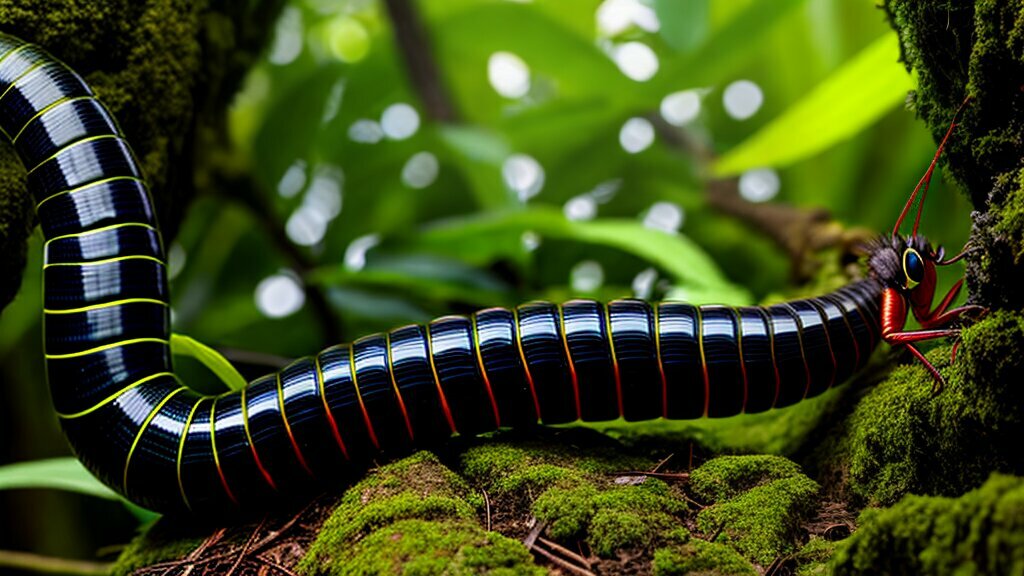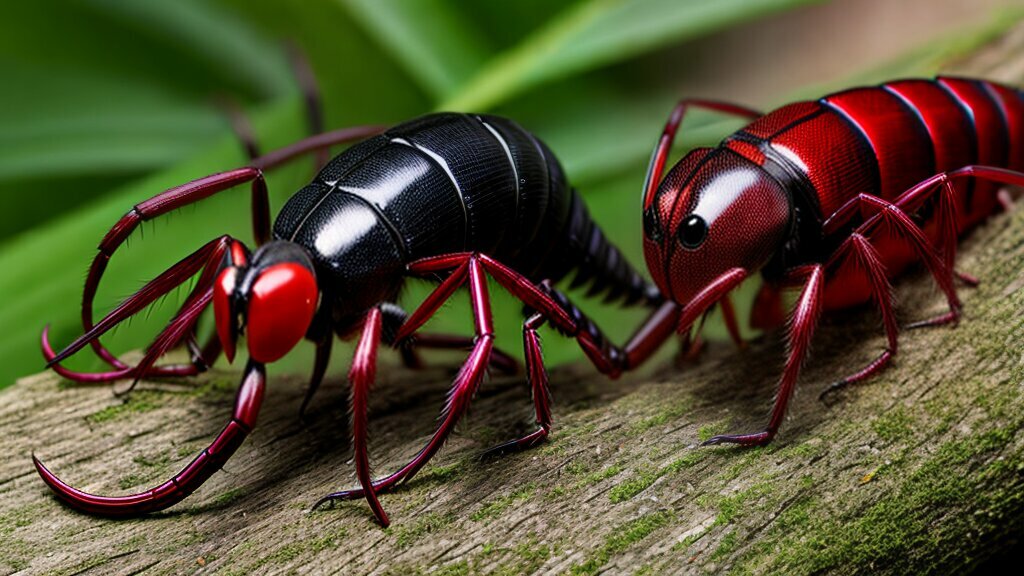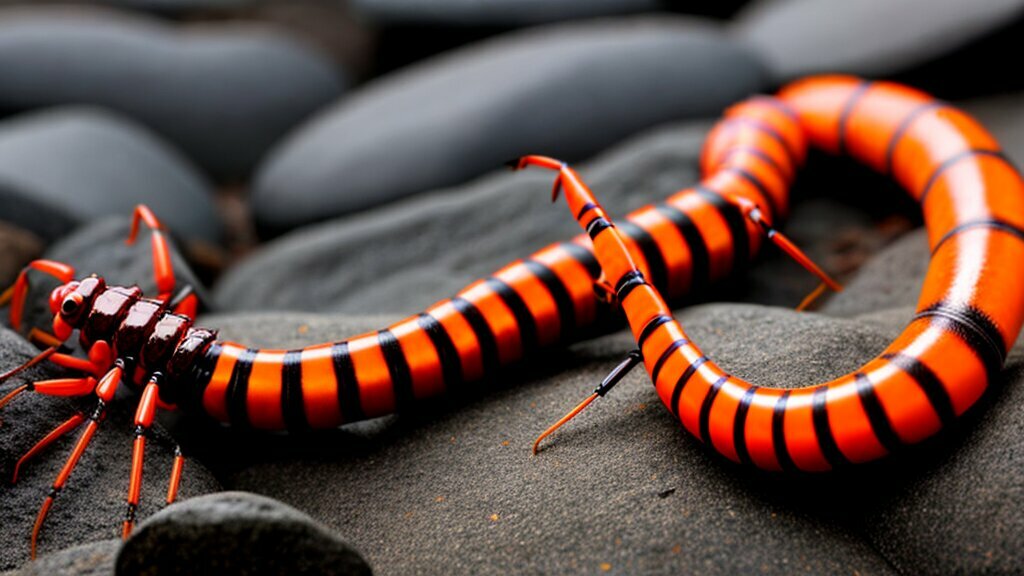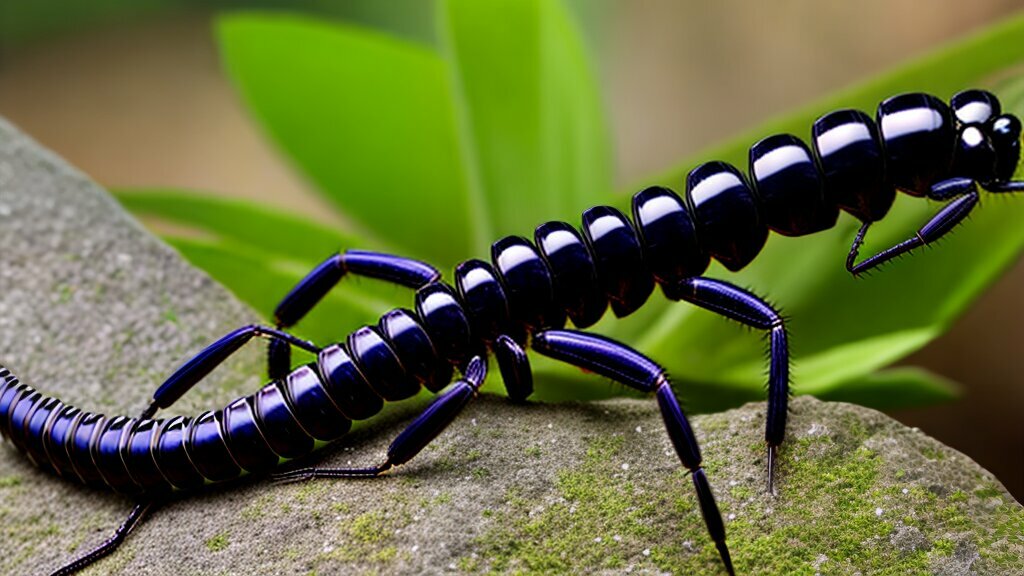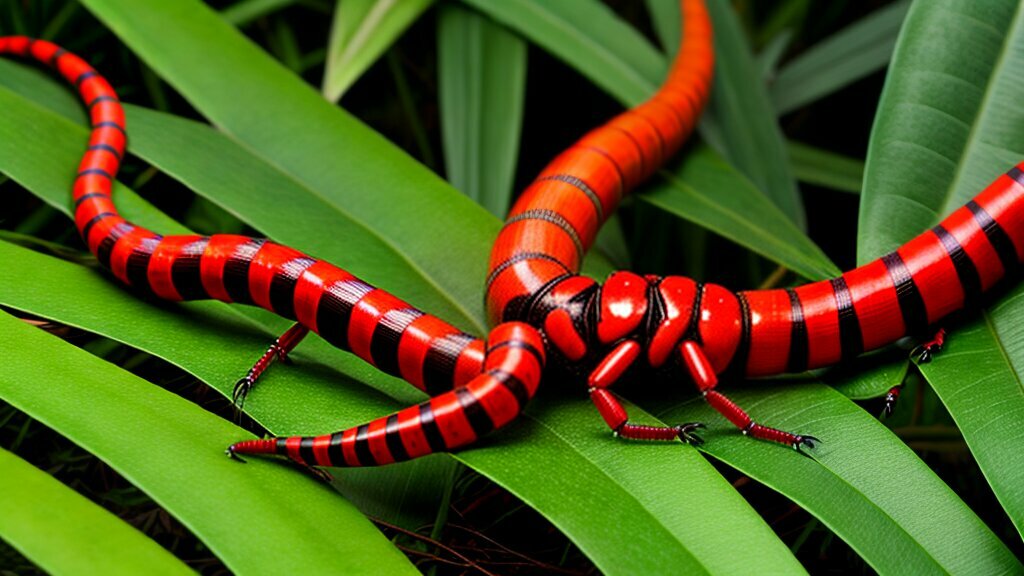If you’re a collector of exotic pets or simply fascinated by the natural world, the Scolopendra Malaysian Jewel is a species worth learning about. This rare centipede species native to Southeast Asia is known for its impressive size, stunning coloration, and venomous nature.
The Scolopendra Malaysian Jewel is a unique specimen that is sure to intrigue anyone with an interest in fascinating creatures. In this article, we’ll delve into the habitat, physical characteristics, and care requirements for this intriguing species. We’ll also explore its venomous nature, handling considerations, and availability for purchase.
Key Takeaways
- The Scolopendra Malaysian Jewel is a rare and exotic centipede species native to Southeast Asia.
- This species is known for its impressive size, stunning coloration, and venomous nature.
- Proper care for the Scolopendra Malaysian Jewel requires attention to its habitat, feeding, and environmental conditions.
- Its venomous nature requires proper handling techniques and precautions to minimize the risk of bites or injuries.
- The Scolopendra Malaysian Jewel is a unique and fascinating creature that provides insights into the natural world.
The Habitat of the Scolopendra Malaysian Jewel
The Scolopendra Malaysian Jewel is a centipede species native to Southeast Asia, specifically found in countries such as Malaysia, Thailand, and Indonesia. Its preferred habitat is in tropical environments such as rainforests, caves, and other damp locations.
These centipedes can be found in a variety of different habitats, from forest floors to rocky outcroppings. They are known for their adaptability and can survive in a wide range of conditions. However, they tend to prefer areas with high humidity and plenty of hiding places, such as leaf litter, rocks, or crevices.
Due to its elusive nature and preference for remote areas, encountering a Scolopendra Malaysian Jewel in the wild can be quite rare.
The Habitat of the Scolopendra Malaysian Jewel
One interesting fact about the Scolopendra Malaysian Jewel is that it is often found in limestone caves. These caves provide a natural shelter and are typically rich in moisture, making them an ideal habitat for this species.
Size and Physical Traits of the Scolopendra Malaysian Jewel
The Scolopendra Malaysian Jewel is a fascinating centipede species with unique physical characteristics. On average, it can reach a length of 20-25 centimeters, although some specimens have been known to grow up to 30 centimeters in length. It has a distinctive body structure, with each body segment adorned with a pair of long, black legs.
The centipede’s coloration is another unique feature, with its exoskeleton showcasing a shimmering green or blue metallic sheen, depending on the light and angle of view. Its body also boasts bright yellow or orange stripes running along its back, contributing to its jewel-like appearance that inspired its name.
Unlike most other centipede species, the Scolopendra Malaysian Jewel possesses a powerful pair of venomous fangs, which it uses to subdue its prey. The venom is composed of a potent cocktail of neurotoxins and other enzymes, causing severe pain, swelling, and – in rare cases – more serious symptoms in humans if bitten.
The centipede’s unique features make it a popular addition to exotic animal collections and terrariums.
Care Guide for the Scolopendra Malaysian Jewel
The Scolopendra Malaysian Jewel is a unique centipede species that requires specific care in a captive environment. Follow these guidelines to ensure the health and well-being of your pet.
Enclosure Setup
| Aspect | Requirement |
|---|---|
| Size | The enclosure should be at least 3 times the length of the centipede and 1.5 times its width. A minimum size of 12 inches by 8 inches is recommended for adult specimens. |
| Substrate | Provide a thick layer of moist substrate, such as coconut coir, to maintain proper humidity levels. |
| Hideout | Include a hideout or shelter in the enclosure where the centipede can retreat and feel secure. |
| Lighting | While not necessary, natural light or a low-wattage bulb can be used to provide a day-night rhythm. |
| Ventilation | Ensure proper ventilation to prevent the buildup of stagnant air and excess moisture. |
Temperature and Humidity
The Scolopendra Malaysian Jewel requires warm and humid conditions similar to its natural environment. Keep the enclosure at a temperature range of 75-85°F (24-29°C) during the day and 65-75°F (18-24°C) at night. Maintain a humidity level of 70-90% by misting the substrate as needed.
Feeding Habits
The Scolopendra Malaysian Jewel is a carnivorous species that feeds on live prey such as crickets, mealworms, and small mice. Offer food once or twice a week, providing prey that is no wider than the centipede’s body. Remove any uneaten prey within 24 hours to prevent contamination.
Handling and Health Considerations
Handle the Scolopendra Malaysian Jewel with care as it is venomous and can deliver a painful bite. Always use proper tools and techniques to minimize the risk of injury. If bitten, seek medical attention immediately as the venom can cause severe pain, swelling, and other symptoms. Regularly monitor your pet’s health and behavior, contacting a veterinarian with any concerns.
Fascinating Facts about the Scolopendra Malaysian Jewel
The Scolopendra Malaysian Jewel is more than just a rare and striking species of centipede. Below are some fascinating facts about this unique creature:
- The Scolopendra Malaysian Jewel is also known as the “Cherry Red Centipede” due to its bright red coloration.
- It is one of the largest centipede species in Southeast Asia, with some individuals growing up to 20 cm in length!
- Despite its impressive size, the Scolopendra Malaysian Jewel is a skilled hunter, using its venomous front legs to capture prey such as insects, spiders, and even small rodents.
- This species is also capable of regenerating lost legs, which can come in handy in case of injury or in a fight with a predator.
- During mating season, male Scolopendra Malaysian Jewels engage in ritual combat, using their legs and venomous fangs to compete for the chance to mate with females.
- Interestingly, the venom of the Scolopendra Malaysian Jewel is being studied for potential medicinal purposes, due to its potential analgesic and anti-inflammatory properties.
- Finally, despite their fearsome reputation, Scolopendra Malaysian Jewels can actually make fascinating and low-maintenance pets in the right setting, such as a secure and temperature-controlled terrarium.
Venomous Nature of the Scolopendra Malaysian Jewel
The Scolopendra Malaysian Jewel is a venomous centipede species that should be treated with respect and caution. Its venom is composed of a potent cocktail of toxins that can cause intense pain, swelling, and even systemic effects in humans.
When threatened or provoked, the Scolopendra Malaysian Jewel may bite to defend itself, injecting venom through its sharp fangs. The effects of a bite can vary depending on the individual and the amount of venom injected, but common symptoms include local pain, redness, and swelling that can last for several days.
In some cases, the venom can cause more severe reactions, such as nausea, vomiting, dizziness, and difficulty breathing. Allergic reactions to the venom can also occur, leading to anaphylaxis, a life-threatening condition that requires immediate medical attention.
It is important to note that handling the Scolopendra Malaysian Jewel without proper precautions can increase the risk of bites. Enthusiasts and collectors should wear protective gloves and avoid direct contact with the centipede as much as possible. It is also recommended to have antivenom on hand in case of an emergency.
Although the Scolopendra Malaysian Jewel’s venom can be dangerous, it is also fascinating in its complexity and potential for medical research. Scientists are currently exploring the use of centipede venom in developing new painkillers and treatments for various ailments.
Lifespan of the Scolopendra Malaysian Jewel
The average lifespan of the Scolopendra Malaysian Jewel is around 5 to 7 years. However, factors such as temperature, humidity, diet, and breeding conditions can affect their lifespan.
In captivity, providing the appropriate environment and diet can help ensure a longer lifespan. It is important to maintain a temperature and humidity range that mimics their natural habitat, as well as providing a suitable enclosure for them to thrive in.
Interestingly, there are reports of Scolopendra Malaysian Jewel specimens living up to 10 years in captivity when given proper care and attention.
It is worth noting that the Scolopendra Malaysian Jewel is known to be aggressive when provoked or threatened, so it is important to exercise caution when handling them to avoid stress or injuries.
Handling the Scolopendra Malaysian Jewel
Handling the Scolopendra Malaysian Jewel requires caution due to its venomous nature. If you need to handle this centipede, it is crucial to take appropriate measures to avoid getting bitten and reduce the risk of injury or allergic reactions.
Always wear protective gear when handling the Scolopendra Malaysian Jewel. This should include gloves, long-sleeved shirts, and pants. While some enthusiasts may prefer to handle the centipede with bare hands, this is highly discouraged, as it can put you at greater risk of being bitten.
Use proper handling techniques. It is recommended that you use forceps or tweezers to pick up the Scolopendra Malaysian Jewel and move it to another location. Do not attempt to grab it with your hands or fingers.
Be mindful of your surroundings. When handling the Scolopendra Malaysian Jewel, ensure that there are no potential hazards nearby. For instance, make sure that you do not drop the centipede onto a hard surface or a place where it can crawl into a small opening and hide.
If bitten, seek medical attention immediately. If you do get bitten, it is essential to seek medical attention as soon as possible. Symptoms of a Scolopendra Malaysian Jewel bite can include swelling, pain, numbness, and respiratory difficulties.
Do not handle the Scolopendra Malaysian Jewel unnecessarily. While it may be tempting to handle your pet Scolopendra Malaysian Jewel, it is best to avoid unnecessary contact. Not only does this reduce the risk of getting bitten, but it also helps to minimize stress for the centipede.
Following these guidelines can help you safely handle the Scolopendra Malaysian Jewel and reduce the risk of getting injured. Always exercise caution when dealing with venomous animals, and seek professional help if you have any concerns or questions.
Availability of Scolopendra Malaysian Jewel for Sale
Due to the uniqueness and rarity of the Scolopendra Malaysian Jewel, finding it for sale can be a challenge. However, it is possible to acquire this species through reputable breeders or exotic pet stores.
It is crucial to ensure that the seller is reputable and follows ethical breeding practices to avoid supporting the illegal wildlife trade. Potential buyers should research the seller’s background and reviews to ensure the well-being of the centipede and its legality in their country.
Additionally, it is important to note that the venomous nature of the Scolopendra Malaysian Jewel requires responsible ownership and handling. Prospective owners should have the necessary knowledge and equipment to provide proper care for this species.
Overall, while the Scolopendra Malaysian Jewel may not be readily available for purchase, interested individuals can potentially find it through reputable sources and should prioritize the health and well-being of the centipede above all else.
Conclusion
The Scolopendra Malaysian Jewel is a rare and fascinating centipede species native to Southeast Asia. Its exotic appearance, venomous nature, and unique characteristics have captured the interest of collectors and enthusiasts alike.
Throughout this article, we have explored the Scolopendra Malaysian Jewel’s natural habitat, size and physical traits, care guidelines, lifespan, and handling precautions. We have also discussed interesting facts and the availability of this species in the market.
Overall, it is important to approach this species with caution and respect due to its venomous nature. However, for those who are knowledgeable and experienced in keeping exotic invertebrates, the Scolopendra Malaysian Jewel can make for a captivating addition to one’s collection.
We encourage further research and exploration on this unique centipede species and hope that this article has provided valuable insights and information for those interested in learning more about the Scolopendra Malaysian Jewel.
FAQ
Q: What is the Scolopendra Malaysian Jewel?
A: The Scolopendra Malaysian Jewel is a rare centipede species native to Southeast Asia.
Q: Where can the Scolopendra Malaysian Jewel be found?
A: The Scolopendra Malaysian Jewel can be found in tropical environments in Southeast Asia, including countries like Malaysia and Indonesia. It typically inhabits habitats such as rainforests and caves.
Q: What are the size and physical traits of the Scolopendra Malaysian Jewel?
A: The Scolopendra Malaysian Jewel has an average length and possesses a number of legs. It exhibits distinct coloration and may have unique features.
Q: How do I care for the Scolopendra Malaysian Jewel?
A: To care for the Scolopendra Malaysian Jewel, it is important to provide the proper enclosure setup, maintain suitable temperature and humidity levels, and feed it appropriately. Additional considerations for its well-being should be taken into account.
Q: What are some fascinating facts about the Scolopendra Malaysian Jewel?
A: The Scolopendra Malaysian Jewel exhibits interesting hunting techniques, reproductive behavior, and unique adaptations.
Q: Is the Scolopendra Malaysian Jewel venomous?
A: Yes, the Scolopendra Malaysian Jewel is venomous. Its venom composition and the effects of a bite should be taken into consideration when handling this species.
Q: What is the average lifespan of the Scolopendra Malaysian Jewel?
A: The average lifespan of the Scolopendra Malaysian Jewel can vary. Factors such as environment and care can influence its longevity.
Q: How should I handle the Scolopendra Malaysian Jewel?
A: When handling the Scolopendra Malaysian Jewel, precautions should be taken due to its venomous nature. Recommended techniques and equipment should be used to minimize the risk of bites or injuries.
Q: Can I purchase the Scolopendra Malaysian Jewel?
A: The availability of Scolopendra Malaysian Jewel for sale may vary. Interested collectors or enthusiasts can explore reputable sources or platforms to potentially find this species.

